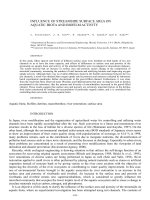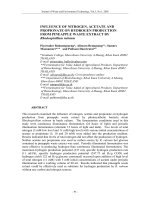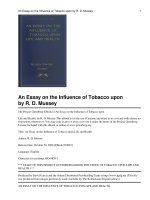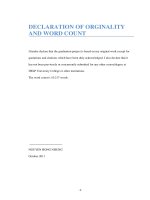Influence of fly ash and blast furnace slag on characteristics of geopolymer non-autoclaved aerated concrete
Bạn đang xem bản rút gọn của tài liệu. Xem và tải ngay bản đầy đủ của tài liệu tại đây (549.44 KB, 8 trang )
<span class='text_page_counter'>(1)</span><div class='page_container' data-page=1>
<b>Transport and Communications Science Journal </b>
<b>INFLUENCE OF FLY ASH AND BLAST FURNACE SLAG ON </b>
<b>CHARACTERISTICS OF GEOPOLYMER NON-AUTOCLAVED </b>
<b>AERATED CONCRETE </b>
<b>Tuan Anh Le1,2<sub>, Thuy Ninh Nguyen</sub>1,2<sub>, Quoc Phong Huu Le</sub>3<sub>, Sinh Hoang Le</sub>4,5<sub>, </sub></b>
<b>Khoa Tan Nguyen4,6*</b>
1<sub>Faculty of Civil Engineering, Ho Chi Minh City University of Technology, Vietnam </sub>
2<sub>Vietnam National University Ho Chi Minh City, Vietnam </sub>
3<sub>Faculty of Civil Engineering, Can Tho Technology of University, Vietnam </sub>
4<sub>Institute of Research and Development, Duy Tan University, Da Nang, 550000, Vietnam </sub>
5<sub>Faculty of Natural Science, Duy Tan University, Da Nang, 55000, Vietnam</sub>
6<sub>Faculty of Civil Engineering, Duy Tan University, Da Nang, 550000, Vietnam </sub>
ARTICLE INFO
TYPE: Research Article
Received: 5/10/2020
Revised: 30/10/2020
Accepted: 6/11/2020
Published online: 25/01/2021
<i> </i>
<i>*<sub> Corresponding author </sub></i>
Email: ; Tel: 0829270589
<b>Abstract. </b>Geopolymer materials are known as sustainable and environmental material. The
main constituents of geopolymer material are alumina and silicon, which can be activated in
an alkaline environment. In this paper, the reaction of alumino-silicate materials in the
alkaline agent is investigated on geopolymer non-autoclaved aerated concrete (GNAAC). The
main constituents of GNAAC are fly ash (FA), blast furnace slag (BSF), lime, gypsum,
aluminium powder, and alkaline solution. In the mix proportions, FA and BSF are used to
replace crushed sand and cement. The results indicate that the GNAAC can be produced
similarly as traditional autoclaved aerated concrete. Besides, the flow diameter of the mixture
using blast furnace slag is lower than that of fly ash. The temperature and expansion ability
decrease with an increase in FA/BFS – Lime and alkaline content. Furthermore, the
compressive strength of GNAAC can be determined by synthesizing geopolymer without
steam and pressure curing conditions.
<b>Keywords: </b>geopolymer, fly ash, blast furnace slag, autoclaved aerated concrete, strength.
</div>
<span class='text_page_counter'>(2)</span><div class='page_container' data-page=2>
<b>1. INTRODUCTION </b>
Autoclaved aerated concrete (AAC) is known as lower embodied energy than traditional
concrete to apply in solve construction methods for urbanization. The foaming agent's
reaction with cement, sand, lime, and gypsum is obtained by high temperature and pressure
condition to produce tobermorite formation. Aerated autoclaved concrete relatively
homogeneous to compare to regular concrete and non-fired brick in microstructure and
composition. Their characteristics depend on the type of cementitious binders in
manufacturing technology, such as mixing by fly ash, blast furnace slag, methods of
pore-formation, and curing condition [1-3].
Nowadays, geopolymer is currently utilized in building construction as a replacement for
cementitious materials. Geopolymer belongs to inorganic polymers and chain structures
formed on a backbone of aluminium (Al) and silicon (Si) ions. Raw materials of geopolymer
should contain an amount of Si and Al. The geopolymerization process, known as the
hardening process, is an exothermic polycondensation reaction involving alkali activation by
caution in solution. This process depends on many parameters, including the chemical and
mineralogical composition of the starting materials, curing temperature, curing time, water
content, and the concentration of the alkaline solution. Hence, geopolymer synthesis involves
mixing an alkali liquid with Si and Al content in activated raw materials to produce hardening
materials [4-8].
Fly ash and blast furnace slag are known as waste materials from thermal power and steel
industries containing activated Si and Al. Thus, fly ash is a by-product of coal combustion
residue, and blast furnace slag is a by-product of pig iron production in a blast furnace. They
consist of silicates, alumino-silicates, and calcium-alumina-silicates, similar to the mineral
composition of cement or pozzolanic material [9-10].
In this research, fly ash and blast furnace slag are used as raw materials to replace the
components of the original AAC mixtures, which are cement and crushed sand. The
properties of geopolymer non-aerated autoclaved concrete (GNAAC), such as workability,
temperature, expansion degree, and compressive strength, have been determined.
<b>2. EXPERIMENT PROCESS </b>
<b>2.1.Materials </b>
</div>
<span class='text_page_counter'>(3)</span><div class='page_container' data-page=3>
5-Table 1.Chemical compositions of fly ash and slag.
Oxide SiO2 Al2O3 Fe2O3 CaO K2O & Na2O MgO SO3 LOI
Fly ash (%) 51.7 31.9 3.48 1.21 1.02 0.81 0.25 9.63
Slag (%) 35.9 13 - 38.13 1.01 7.5 - 1.15
*LOI: Loss of Ignition
Table 2.Mix proportions GNAAC with fly ash and blast furnace slag.
<b>Mixture </b> <b>FA </b>
<b>(kg) </b>
<b>BSF </b>
<b>(kg) </b>
<b>L </b>
<b>(kg) </b>
<b>G </b>
<b>(kg) </b>
<b>Al </b>
<b>(kg) </b>
<b>AL </b>
<b>(l) </b>
<b>W </b>
<b>(l) </b>
<b>F1L1 </b> 300 0 200 20 2.5 18.75 356.25
<b>F1L2 </b> 300 0 200 20 2.5 37.5 337.5
<b>F1L3 </b> 300 0 200 20 2.5 56.25 318.75
<b>F2L1 </b> 318 0 182 20 2.5 18.75 356.25
<b>F2L2 </b> 318 0 182 20 2.5 37.5 337.5
<b>F2L3 </b> 318 0 182 20 2.5 56.25 318.75
<b>F3L1 </b> 333 0 167 20 2.5 18.75 356.25
<b>F3L2 </b> 333 0 167 20 2.5 37.5 337.5
<b>F3L3 </b> 333 0 167 20 2.5 56.25 318.75
<b>S1L1 </b> 0 300 200 20 2.5 18.75 356.25
<b>S1L2 </b> 0 300 200 20 2.5 37.5 337.5
<b>S1L3 </b> 0 300 200 20 2.5 56.25 318.75
<b>S2L1 </b> 0 318 182 20 2.5 18.75 356.25
<b>S2L2 </b> 0 318 182 20 2.5 37.5 337.5
<b>F2L3 </b> 0 318 182 20 2.5 56.25 318.75
<b>S3L1 </b> 0 333 167 20 2.5 18.75 356.25
<b>S3L2 </b> 0 333 167 20 2.5 37.5 337.5
</div>
<span class='text_page_counter'>(4)</span><div class='page_container' data-page=4>
<b>2.2.Testing </b>
The mix proportion of GNAAC with 500 kg/m3 dry in density is investigated. The ratio
of fly ash/ blast furnace slag – lime ranged from 1.5 to 2 by weight is investigated. The
proportion of GNAAC with fly ash and blast furnace slag is shown in Table 2. The standard
ASTM C956 and C39 were used to evaluate the workability (flow), expansion properties, and
strengths (at 7 and 28 days) of GNAAC specimens, as shown in Fig. 1 and 2.
Figure 1. Flow test. Figure 2. Expansion test.
<b>3. FIGURES AND TABLES </b>
<b>3.1.Influence of fly ash and slag on the flow of GNAAC </b>
In this study, the content of aluminium and silicon in GNAAC using FA is varied by the
ratio of fly ash and lime. The effects of aluminium and silicon contents are presented by the
value of CaO/ SiO2 and CaO/ (SiO2 + Al2O3) shown in Fig. 3a. According to this figure, with
an increase of fly ash/lime ratio, both CaO/ SiO2 and CaO/ (SiO2 + Al2O3) ratio decrease from
1.05 to 0.8 and 0.68 to 0.52, respectively. In the mixture using fly ash, the ratio of SiO2/Al2O3
is 1.84 by weight. Based on the previous research [7], the networks of geopolymer materials
is varied between poly (sialate) in the case of SiO2/Al2O3 ratio ranged from 1 to 2 and poly
(sialate-siloxo) in the case of SiO2/Al2O3 ratio ranged from 2 to 3. Thus,poly(sialate) can be
the final product ofthe reaction between fly ash and alkaline environment.
In terms of workability, the flow diameter of three mixtures F1, F2, and F3 decreases
approximately 16 to 30% when alkaline liquid changes from 5 to 15% by weight, as shown in
Fig. 3b. However, the mixture with higher fly ash content has a contrary trend compared with
the flow diameter. When the fly ash/lime ratio increases from 1.5 to 2, the flow diameter
value increases by about 41.7% in the case of mixture F1, 49.5% and 62% for mixture F2 and
F3, respectively. It is indicated that fly ash particles can be increased in workability, but
alkaline content affected the fresh mixture's plastic viscosity.
</div>
<span class='text_page_counter'>(5)</span><div class='page_container' data-page=5>
and more reducing with increase in alkaline content, as seen in Fig. 3d. The results can be
explained that spherical particles of FA are smoother than the rough surface of BFS. In
general, all mixtures' workability is significantly affected by FA/BFS ratio and alkaline
content.
Figure 3. Influence of fly ash and slag on workability.
<b>3.2.Influence of fly ash and slag on expansion properties of GNAAC </b>
As seen in Fig. 4a and Fig. 4b, the foamed mixture F1L1 is shown to value 700C and 95%
in the temperature and expansion degree, respectively. The temperature expansion of mixtures
F1 slightly decreased from 70 to 670C with added alkaline content from 5 to 15% at FA/Lime
ratio of 1.5. While in the mixture F2 and F3, the temperature expansion decreased to 550C –
580<sub>C. </sub>
</div>
<span class='text_page_counter'>(6)</span><div class='page_container' data-page=6>
Figure 4. Influence of fly ash and slag on expansion temperature and expansion ability.
Moreover, Fig. 4c presents the relationship between ratio of alumino-silicate/lime and
expansion degree in mixtures using BFS and FA. According to Fig. 4c, the expansion degree
in BFS is lower than FA 10-12% with the same lime content. Mixing with alkaline liquid, the
expansion degree of mixture BFS is also lower than FA, as seen in Fig. 4d. It can be indicated
that the expansion degree of FA and BFS mixture are relative with temperature and
flowability. Hence, the measurement in flow-diameter and reaction temperature can be
designed in the volume of porosity.
<b>3.3.Influence of fly ash and slag on compressive strength of GNAAC </b>
Overall, the compressive strength of GNAAC is affected by the content of FA and BSF. As
shown in Fig. 5a, the compressive strength of mixture F1L1 is about 1.6 and 2.3 N/mm2 at
7-day and 28-7-day, respectively. While the compressive strengths of F2L1 are (1.5 and 2.2
N/mm2), and (1.3 and 1.6 N/mm2) for F3L1 at 7-day and 28-day, respectively.
</div>
<span class='text_page_counter'>(7)</span><div class='page_container' data-page=7>
ratio; they show lower strength than F1L1. However, the strength of GNAAC can increase up
to 30% with an increase of alkaline content, as seen in Fig. 5b. It is known that the synthesis
of geopolymerization can be improved by adding Na2O.
Figure 5. Influence of fly ash and slag on the compressive strength of GNAAC.
On the other hand, Fig. 5c and 5d show the relationship between the ratio of
alumino-silicate – Lime and strength in BFS and FA mixture. Based on two these figures, the strength
of BFS mixtures is higher 30-40% than that of FA mixtures after 28-day curing. It is noted
that the BFS particle with 43% content of alumino-silicate is lower than that of FA (83%).
However, BFS raw material, which contains the SiO2/Al2O3 ratio of 1.84, can be obtained
thepoly<i>(</i>silixo<i>)</i> in the final structure. Thus, the reaction of a mixture using BFS can strongly
happen. Therefore, GNAAC can match well <i>with </i>the requirements of AAC-4 and AAC-6 in
the ASTM 1693-09.
<b>4. CONCLUSION </b>
The research on the effect of fly ash and blast furnace slag on GNAAC has some results
as following:
</div>
<span class='text_page_counter'>(8)</span><div class='page_container' data-page=8>
30% compared with the FA mixture.
- The temperature and expansion ability tend to decrease with an increase in FA/BFS –
Lime and alkaline content. The reaction of aluminium powder and alkaline environment can
reduce using a large amount of FA/BFS and alkaline liquid. Besides, a mixture with BFS
showed lower porosity than that of FA in foamed concrete.
- Finally, the compressive strength of GNAAC can be determined by synthesizing
geopolymer without steam and pressure curing conditions after 28-day. The compressive
strength of GNAAC also satisfiesthe requirements AAC-4 and AAC-6 in ASTM 1693-09,
with FA and BFS, respectively.
<b>ACKNOWLEDGMENT </b>
This research is funded by Vietnam National University Ho Chi Minh City (VNU-HCM)
under grant number B2020-20-01.
<b>REFERENCES </b>
[1]. RILEM Technical Committees, Autoclaved aerated concrete, Properties, testing and design, 1993.
[2]. T. T. Mitsuda, K. Sasaki, H. Ishida, Influence of Particle Size of Quartz on the Tobermorite
Formation, in Advances in Autoclaved Aerated Concrete, Edited by F. H. Wittmann, Balkema, 1992,
pp. 19-26.
[3]. G. Li, X. Zhao, Properties of concrete incorporating fly ash and ground granulated blast-furnace
slag, Cem. Concr. Compos., 25 (2003), 293-299.
[4]. A. Fernadez-Jimenez, A. Palomo, M. Criado, Microstructure development of Alkaline-activated
fly ash cement: a descriptive model, Cem. Concr. Res., 35 (2005), 1204-1209.
[5]. P. Duxson et al., Understanding the relationship between geopolymer composition,
microstructure and mechanical properties, Collois Surf. A Physicochem. Eng. Asp., 269 (2005) 47-58.
[6]. D. Hardjito, B.V. Rangan, Development and properties of low-calcium fly ash-based geopolymer
concrete, Research Report GC1 Faculty of Engineering Curtin University of Technology Perth,
Australia, 2005.
[7]. J. Davidovits, Geopolymer Chemistry and Application, 3rd ed., Geopolymer Institute, 2011.
[8]. K. T. Nguyen et al., Investigation on properties of geopolymer mortar using preheated materials
and thermogenetic admixtures, Constr. Build. Mater., 130 (2017) 146-155.
[9]. A. Allahverdi et al., Effect of blast-furnace slag on natural pozzolan-based geopolymer cement,
Ceramics – Silikaty, 55 (2011) 68-78.
</div>
<!--links-->









